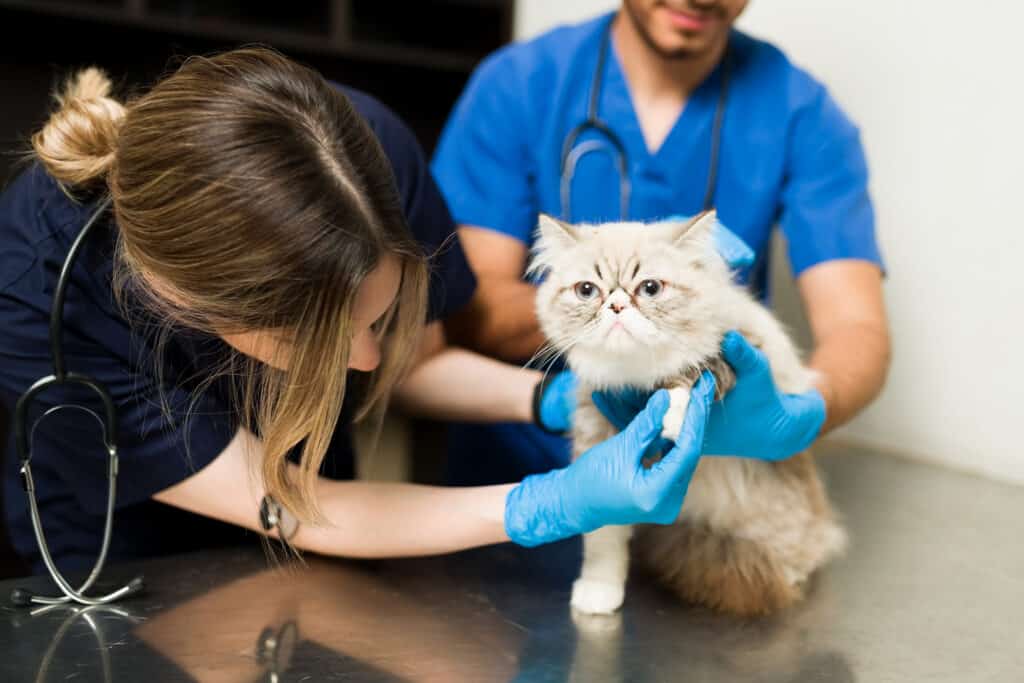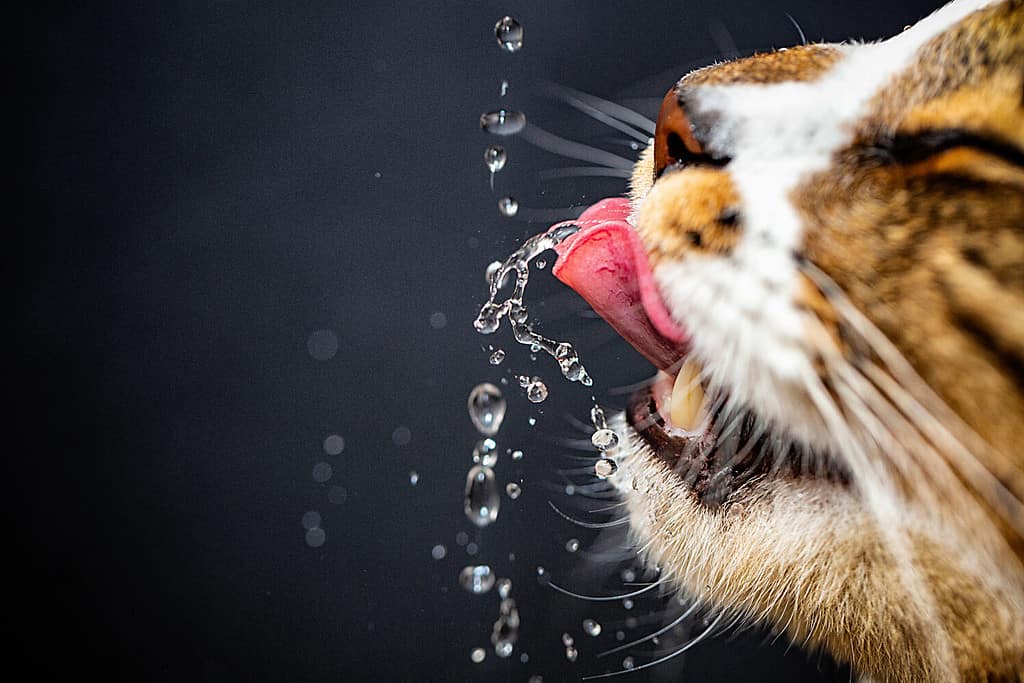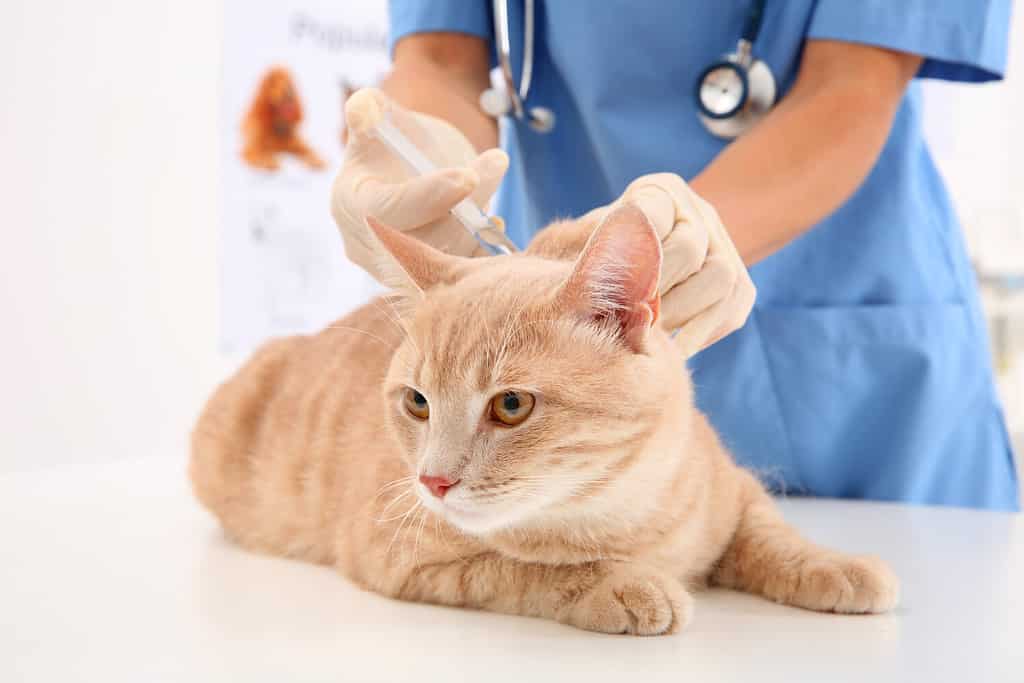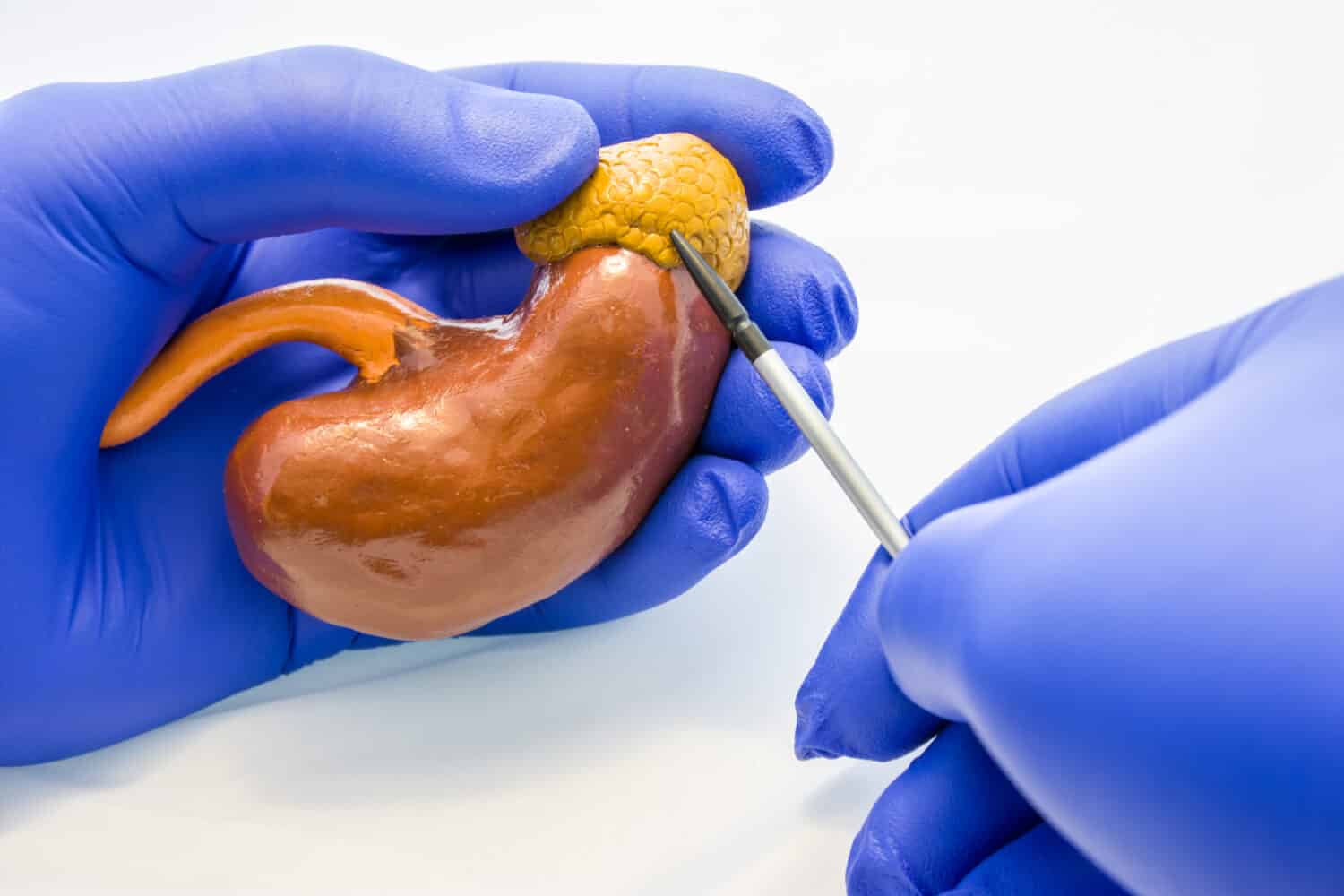
Only veterinarians should decide if it’s safe to use prednisolone for your cat.
©Beach Creatives/Shutterstock.com
Prednisolone is a steroid medication veterinarians use to treat a variety of conditions in cats. Most veterinarians prescribe it for short periods and use a tapering dose. A tapering dose involves starting with a higher dose and slowly stepping down the strength and/or frequency over time. This medication has the potential for serious side effects, which we’ll go over later.
Cats must take only prednisolone, as opposed to prednisone. The medications are similar, so why is this important to know? Well, it’s because cats are unable to break prednisone down into prednisolone for their body to use. Dogs and humans both process prednisone through the liver and break it down into the useable form (prednisolone), so they can take either medication.
With this information in hand and that to come, we remind anyone reading this article that giving medication of any kind to your pet requires a veterinarian’s advice and direction. This article does not replace veterinary advice. Failure to consult a veterinarian before giving medication to your cat could result in major side effects up to and including death.
Read on to learn the uses, side effects, dosage, and more of prednisolone in cats.
What is Prednisolone Used for in Cats?
Again, prednisolone is a steroid. Generally, these medications facilitate subduing the immune system. That means the drug shuts the body’s defense mechanisms off or slows them down. This helps in reducing inflammation, as well as, stopping the body from attacking itself (autoimmune disease).
Some humans use steroids to build muscle. Unfortunately, taking prednisolone won’t make your cat buff. Performance-enhancing steroids are an entirely different class, but they have a similar effect in other ways. The reason that they work to get humans shredded is that they change hormone levels within the body, among other effects. The side effects are rarely worth the muscular results for humans, though.
Let’s learn about the most common uses of prednisolone in cats!
Stomatitis
According to Animal Dentistry & Oral Surgery in Leesburg, VA, “Stomatitis is a chronic inflammatory disease which often requires life-long treatment.” This condition makes the gums react to the teeth as foreign material. This sends the body’s defenses into overdrive in an attempt to destroy them. It results in severely damaged teeth and swollen, red, painful gums. Stomatitis often results in halitosis (bad breath) and a refusal to eat. These symptoms can lead to weight loss along with a very angry kitty.
The first line of treatment for stomatitis remains full mouth extractions. That is surgical removal of most or all of the teeth. If the canine teeth and incisors remain healthy and without inflammation, some surgeons choose to leave them. Once the teeth are removed and the surgical sites heal, some cats still experience inflammation. In such cases, prednisolone is an inexpensive and fast-working treatment. An important note is that the use of prednisolone during the healing process may delay healing.

Stomatitis is an autoimmune condition affecting the gums in cats.
©mojahata/Shutterstock.com
Severe Allergies
Just like us, some animals experience allergies. Many allergy medications exist for pets. However, some of these are not safe for cats or become very expensive for pet owners to use. Short courses of prednisolone can help a cat through an allergy flare-up if they have seasonal allergies. It can also help if the cat develops an allergy to flea bites while they wait for flea prevention to begin working.
Cats impacted by feline asthma along with their allergies also benefit from prednisolone. Veterinarians often use this medication in low doses alongside an inhalant steroid to help relieve swelling in the lungs and throat. Because of its ability to reduce inflammation and subdue the immune system, it can help prevent asthma attacks, as well.
Lastly, prednisolone can help treat inflammatory bowel disease in cats. This condition usually happens when the body has an allergic reaction to certain foods in the intestines, so it can make those reactions less severe.

Cats can be allergic to flea bites which causes them to damage their skin by scratching more than usual.
©Thrithot/Shutterstock.com
Other Conditions
Some other conditions that veterinarians prescribe prednisolone for in cats include joint pain, cancer, hypercalcemia (too much calcium in the blood), and central nervous system disorders. These conditions are not necessarily unique to cats (nor are they particularly common), so we won’t discuss them in full.
Pre-treatment with prednisolone in cats with gastrointestinal lymphoma may reduce the ability of chemotherapy drugs to kill cancer cells, according to one study. Regarding joint pain, other medications (such as Solensia) are now available to help with this condition as it relates to feline osteoarthritis.
Side Effects of Prednisolone in Cats
The most common side effects of prednisolone in cats include increased thirst, appetite, and urination. These are considered normal reactions to the medication. Let’s list more serious problems that could occur. Remember, if you think your cat is having a side effect of any medication, the best thing to do is call your veterinarian right away!
Possible side effects include:
- Increased thirst
- Increased urination
- Increased appetite
- Weight gain
- Pot-bellied appearance
- Panting
- Skin/coat changes including hair loss and skin rashes
- Fever
- Diarrhea
- Vomiting
- Lethargy/lack of energy
- Refusal to eat
- Painful urination
- Infections (due to suppressed immune system) – particularly urinary tract infections and upper respiratory infections
- Increased blood sugar levels
- Induced labor or spontaneous abortion in pregnant animals
- Difficulty breathing
- Bleeding/ulceration of the stomach or intestines
- Increased blood cholesterol and circulating fats
- Behavior changes (aggression) – yep, “roid rage” is real even in animals!
- Liver damage
- Diabetes

Prednisolone commonly causes excessive thirst in cats.
©AltamashUrooj/Shutterstock.com
When Should Cats Not Take Prednisolone?
According to AZ Animals’ interview with Dr. Julie Parks, a licensed Doctor of Veterinarian Medicine at Northwood Hills Animal Hospital, “Prednisolone should be avoided in young cats because it can impair their growth. It should also be used with extreme caution in diabetic cats as it can affect blood sugar.” These reasons are not the only ones that prevent the use of prednisolone in cats. Let’s learn more below!
Medications Your Cat Cannot Take With Prednisolone
Some medications increase the risk of side effects of prednisolone in cats. That’s why it is all-important to discuss all medications your cat takes with your veterinarian before starting any new ones. This includes over-the-counter medications, as well as, supplements and vitamins. Let’s cover some medications and what risks they increase when given alongside prednisolone in cats. This is not a complete list, by any means!
- Non-steroidal anti-inflammatory drugs (NSAIDs): Both NSAIDs (such as Onsior or meloxicam) and prednisolone increase the risk of stomach ulcers or bleeding in the stomach/intestines.
- Cyclosporine: Another type of immunosuppressive drug, cyclosporine treats allergies and other autoimmune diseases in cats. Using this with prednisolone in cats can wipe out the immune system and result in terrible infections.
- Furosemide: This diuretic medication (one that causes the body to pull fluid into the urinary system for expulsion) can lead to hyperkalemia (or too much potassium in the blood) when combined with prednisolone. Since both medications also increase thirst and urination, using them together is not recommended.
Conditions That Prevent Your Cat From Taking Prednisolone
As Dr. Parks told AZ Animals, some conditions require prednisolone in cats to be carefully monitored as they can be worsened by its use. We’ll include some of those conditions below along with the reasons why prednisolone should be avoided or used with caution in cats.
- Diabetes: Prednisolone can increase blood sugar levels in cats which makes regulating diabetes very difficult. Prolonged high blood sugar levels can lead to diabetic ketoacidosis and death. Long-term use of prednisolone in cats can also cause diabetes.
- Liver disease: Prednisolone processes through the liver. Cats with liver damage already present may be unable to process prednisolone and use it efficiently.
- Pets undergoing allergy testing within 30 days: The use of any steroids before allergy testing can alter the results and render them useless.
- Infections: Bacterial, fungal, or viral infections can all become much worse with the use of prednisolone because of immunosuppression.
- Cushing’s Disease: Steroids contain a synthetic version of cortisol. Pets with Cushing’s already produce too much of this chemical. Long-term use can cause Cushing’s disease. If left untreated, this condition leads to thinning of the skin and weakness.
- Pregnancy: Spontaneous abortion or induced labor can occur. Abortion, of course, results in the loss of kittens. Inducing labor too early will result in kittens that are premature and may not survive.

Prednisolone can cause diabetes in cats which results in a need for insulin injections.
©Africa Studio/Shutterstock.com
Dosage Chart for Prednisolone in Cats
Always follow your veterinarian’s instructions exactly and finish the prescribed course unless otherwise instructed, even if your cat appears to be feeling 100% better.
The typical prednisolone dose for cats is between 0.1 mg and 3 mg per pound depending on the condition requiring treatment. Usually, the dose is given every 12 hours for 3–7 days, then every 24 hours for 3–7 days, then every other day for 3–7 doses. Prednisolone comes in injectable, liquid, and tablet forms. It can also be compounded into dosage forms and strengths not commercially available. Long-term prednisolone dosing in cats is most often given at the minimum effective dose (MED). MED is the least amount of drugs a patient can take and still experience the desired results.
| Cat’s Weight in Pounds | Prednisolone Dosage | Cat Breeds Include |
|---|---|---|
| 0-5 | 0.1-15 mg per dose initially | Singapura, Bambino |
| 6-10 | 0.6-30 mg per dose initially | Siamese, Cornish Rex |
| 11-20 | 1.1-60 mg per dose initially | Bengal, Ragdoll |
| Over 20 | consult your vet | Maine Coon, Savannah |
Why is a Tapering Dose Important?
The tapering dose of prednisolone we discussed earlier is very important in cats. That’s because prednisone is a glucocorticoid hormone which is something the cat’s body already produces in small amounts on its own in the adrenal gland. The body becomes used to the increased levels of this hormone. When the medication is stopped abruptly, the adrenal gland goes into overdrive to create the suddenly missing hormone. This can lead to Cushing’s disease. By slowly reducing the amount of increased hormones, the body is weaned off of them and does not react this way.

The adrenal glands are located at the front end of the kidney on each side in cats, dogs, and humans.
©Shidlovski/Shutterstock.com
Final Thoughts on Prednisolone for Cats
Prednisolone is an incredibly useful drug in cats. It helps with inflammation, joint pain, autoimmune disorders, neurological problems, and more. However, prednisolone also has the potential to cause some gnarly side effects if used without caution. As always, owners should never give a cat any medication without first discussing it with their veterinarian.
The photo featured at the top of this post is © Piskova Photo/Shutterstock.com
Thank you for reading! Have some feedback for us? Contact the AZ Animals editorial team.






